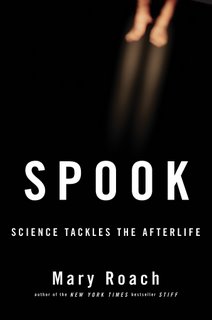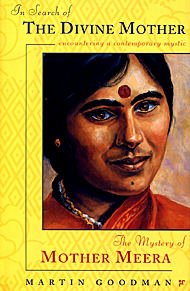 Spook: Science Tackles the Afterlife. Mary Roach
Spook: Science Tackles the Afterlife. Mary RoachSpook provides a light-hearted look at the current status of research into the existence and survivability of the soul. Mary Roach calls it "a book for people who would like very much to believe in a soul and in an afterlife for it to hang around in, but who have trouble accepting these things on faith." At the end of the book, she admits that she began this project "from a state of near absolute ignorance." This is one of the book's most endearing features, since the reader gets a glimpse of how Ms. Roach goes about researching a topic.
The book does not end up with a definitive answer. If science had proof for or against the afterlife, it would have been big news. So this is an exploration of the current state of the research. The author claims that she does not approach the topic as a debunking skeptic, but she does throw in a lot of humorous asides in an attempt to amuse as well as explore.
Chapter One, "You Again," is about reincarnation. Ms. Roach goes to India for a week to visit Kirti S. Rawat, director of the International Center for Survival. Her purpose is to accompany him as he examines a claimed case of reincarnation. She meets the child, his family, and the family of the deceased man that the child claims to be. She also runs into cultural differences in a society where many people believe in reincarnation and don't need scientific proof.
The second chapter is a historic discussion on past research by people who believed there was a soul. Questions such as whether the soul came from the sperm or the ovum, or whether it entered the fetus at some point in its development are reviewed. Also looked at are those who searched for the exact bodily organ that contained soul.
"How to Weigh a Soul" is the third chapter. It explores the research done to see if the soul has weight. If so, can a drop in weight at death be proof of the existence of the soul leaving? The famous experiment by Duncan Macdougall that determined the soul weighs 21 grams is reviewed as well as other more recent attempts. The fourth chapter goes on to look at the attempts to photograph or capture an image of the soul as it leaves the body.
The next couple of chapters delve into the claims of mediums who say they can establish communication with departed spirits. Chapter 5 is a history of the attempts by mediums to produce ectoplasm, a physical manifestation of spirit energy. Chapter 6 then goes on to look at current research with gifted mediums at the VERITAS Research Program of the University of Arizona conducted by Gary Schwartz. This is followed by the author taking a Fundamentals of Mediumship course at Arthur Findlay College in England.
Chapter 8 "Can You Hear Me Now?" looks into attempts to use technology to establish communication with dead souls. EVP (Electronic Voice Phenomena) on tape recorders and radio static is the current trend, but Ms. Roach also looks into the history of this field.
Chapter 9 begins a section where Ms. Roach looks to see if physical phenomena, rather than spirits, may cause the feelings of contact with the beyond. First she visits Dr. Michael Persinger at the Consciousness Research Lab at Laurentian University in Sudbury Ontario. He is studying the ability of complex electromagnetic fields to produce hallucinations that might resemble contact with the dead. Chapter 10 looks into whether low frequency sound waves (10 - 20 hertz) could do the same thing. Ms. Roach visits Vic Tandy who teaches at Coventry University whose research is in this area.
Chapter 11 is my personal favorite. It deals with a 1925 North Carolina ghost who appeared to his son to tell him where to find the most recent version of his will. The case went to court and the new will was accepted by the family. Both the old and new wills were on file in the courthouse, and Ms. Roach brings in the president of the American Society of Questioned Document Examiners. Although the family decided to accept the new will, it turns out to be a poor quality forgery. Yet the story of family intrigue is so interesting that the chapter left me wanting someone to write more about this case.
The last chapter looks into what Mary Roach feels is the most promising of the current research to prove the existence of the soul. Based on the reports of people who have had Near Death Experiences (NDEs) who claim they felt themselves rising out of their bodies and looking down on the room they are in, this research places an object that can only be seen from the ceiling in rooms where people might possibly experience an NDE. Interviews are then conducted to see if they experienced an NDE and saw the object. This research is being conducted by Bruce Greyson at the University of Virginia.
The books ends with a 13 page bibliography that goes chapter by chapter through the resources Mary Roach used for the book. Some may criticize her for attempting to write such a book without being an expert in the field. I find that her newness to the topic gives her a fresh unbiased perspective. However, I feel that she attempts to cover her inexperience with humor that sometimes detracts from the work. If you can endure the jokes, the information provided is well presented.





